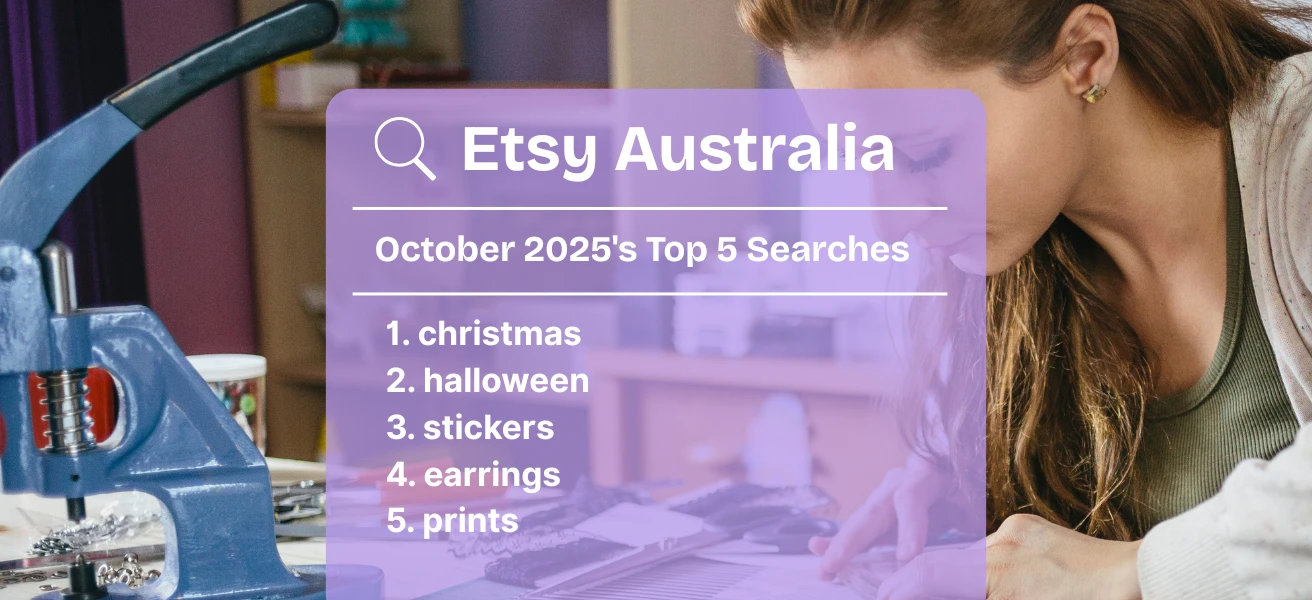This post is also available in: Français
When selling on Etsy, one of the keys to success is choosing the right keywords for your products. But how do you go from a broad keyword to a selection of long-tail and niche keywords that attract the right buyers? This guide shows you how to, using the tools offered by Etsy and eRank.
TLDR
Choosing the right keywords is crucial to success on Etsy. Start with trending broad keywords, which you’ll find with eRank’s Trend Buzz and Monthly Trends tools, then dig deeper with the Keyword tool to find more specific long-tail keywords that attract targeted buyers. Diversify your keywords while remaining relevant to your products.
To navigate directly to a specific section:
- Types of keywords
- Where to find hot keywords
- Tips for discovering niche keywords alongside trending ones
- Case study
What are generic or broad keywords
Short or broad keywords are very general terms made up of one or two words. For example, a broad keyword might be “jewelry” or “bracelet” if you sell handmade jewelry. These terms capture a wide range of searches but are also very competitive.
What are long-tail keywords
Long tail keywords are more specific phrases, usually consisting of three or more words. For example, “handmade silver bracelet” is a long-tail keyword. These terms are less sought-after than broad keywords but are less competitive and attract a more targeted audience. Using these keywords can help with your Etsy shop’s SEO optimization.
Why use long-tail keywords
Using long-tail keywords lets you attract potential buyers who know exactly what they want. This increases the likelihood of conversion and reduces competition with other sellers using more general terms.
Length of long-tail keywords
A good long-tail keyword generally consists of 3 to 5 words. This length allows you to target precisely what the buyer is looking for while retaining the flexibility to capture different search variants.
On Etsy, a tag can contain 20 characters in English and 30 in French. You may need to split up a long-tail keyword into multiple tags. Should this occur, try to divide the keyword where it makes the most sense. For example, if your keyword was “Sterling Silver Gemstone Necklace”, you could split that into “Sterling Silver” and “Gemstone Necklace” for your tags.
How to do keyword research
First, identify broad terms describing your products and research search terms in those categories. Your keywords should be as varied as possible while still being relevant to what you are selling:
- Article description: sterling silver earrings
- Description of materials and techniques used: Wood carving, organic cotton
- Recipient: grandparents, a teenager, a newborn
- The occasion for which it can be purchased: Christmas, Mother’s Day, birthdays
- What is its purpose: Decorating a child’s bedroom
- What is its style: boho, retro, minimalist
- What is its size: A4, A5, miniature, XXL
Where to find trending broad keywords
- By observing the titles and descriptions of similar products on Etsy via the eRank Browser Extension, you can verify that they are indeed products that attract buyers and generate sales.
- Using eRank’s Trend Buzz tool will give you the keywords most searched for by buyers for the last 30 days, the previous seven days, and yesterday in many countries.
- eRank’s Monthly Trends tool gives you the most popular keywords over the last 12 months.
- By consulting the Monthly Keyword Report for France in French and the USA, Canada, Great Britain, and Australia in English, you can see the most popular keywords for those countries.
How to find the best keywords for your niche
Starting with your broad keyword, use eRank’s keyword research tool and look at the keyword ideas to explore more specific variants, checking average buyers search for these keywords.
No matter how relevant a keyword is, it should generate a certain volume of search for your listings to be visible and potentially generate sales.
Choosing keywords that are not relevant will fail to generate the expected engagement, ultimately hurting your visibility and ranking.
Case study
Let’s take an example to illustrate niche keyword research.
Step 1 – Monthly Trends tool
Let’s say I sell wall clocks. I go to the Monthly Trends tool to see which searches have been the most popular with buyers. I see wall art in the 5th position for July 2024, corresponding to the category of items I sell.

Step 2 – Keyword tool
I click on wall art, which takes me to the Keyword Tool and the analysis for “wall art” for the USA on Etsy. Taking a look at the Search Trend graph, we can see that it’s been a viral keyword for over a year. However, it’s very generic, as wall art can describe so many different things. There is also a lot of competition for this term, so it will be very challenging to get into the top search results for it. For these reasons, it may not the best keyword to optimize your SEO on Etsy.

Just below, there’s a section with related keywords. These are keywords in the same word family, in the same niche, or listed in the same Etsy category.
You can sort all fields by column, select the fields you wish to be displayed (by clicking on the orange Columns button on the right), and by:
- Default Match
- Phrase
- Exact
- Broad
- You can request that the query contain specific keywords and/or exclude others
- To see only the tags contained in the first 100 product files that rank for this Keyword search

So, I’ll display only related keywords that contain the term clock and are among the Top Tags. Then, I’ll sort my columns to display the most searched keywords first.

I’m then presented with a selection of precise keywords (only a tiny part of which are shown; the nuggets will be further down the list), for which I see the search trend curve for the last 15 months, the number of searches, clicks and average CTR, averaged over the previous 12 months, as well as the number of listings using this keyword.

In this case, the keyword ‘oversized wall clock’ is interesting because it has a high search volume in relation to the number of competitors, and it also has a high click-through rate, meaning buyers click on the listings that they see when performing a search on Etsy.
To ensure I can fit it into my tags, I added the column that gives me the number of characters of the Keyword: just 20, perfect for English.
It’s a tag that gives an idea of the size of my product. I could also choose from the list keywords that describes its style, like art deco clock, or one that explains which room my clock is designed for, like a living room clock.
Step 3 – Keyword List
I then create a list of keywords to save all the relevant ones for comparison once I’ve finished my research. From there, I can choose the ones I will add to my product listing. To learn more about creating Keyword List, read this article.
Here, I have keywords describing my item, its size (oversized wall clock), its style (art deco clock), and the the room it is for (living room clock). Now, I’m also going to look for tags describing the materials and manufacturing techniques, the recipient, and finally, what occasion it could be bought for.
The Trend Buzz and Monthly Trends tools are also a perfect starting point for this research, based on the keywords most searched for by buyers, even if they are generic.
The Trend Buzz tool even lists trending keywords sorted by color, product, recipient, style, and material!
Adopting a long-tail keyword strategy is important to optimise your visibility on Etsy especially if you are a new seller.
By using tools like eRank, you can niche down hot trending generic keywords into a list of effective long tail keywords that will attract buyers ready to buy.
Head to erank.com now to explore the keywords that will help enhance your visibility on Etsy.








